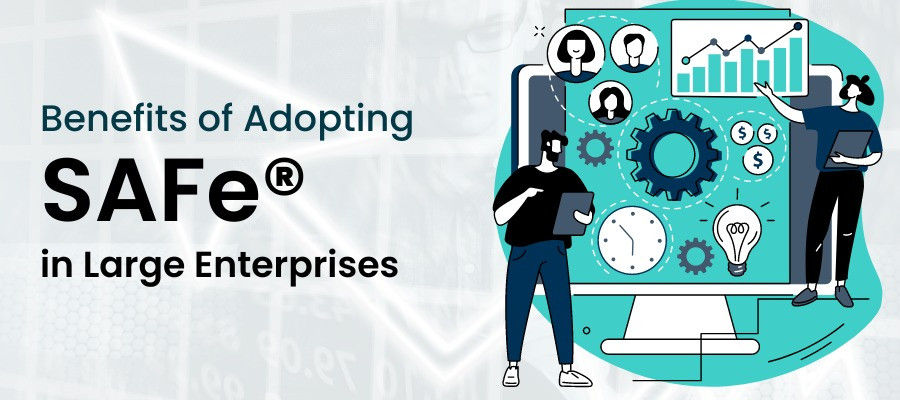The Benefits of Adopting SAFe® in Large Enterprises

The expansion of the software industry has resulted in a corresponding increase in the complexity of challenges encountered by large programs and organizations. Regardless of its source, any issue can have significant consequences for any of the three components of the project management triangle - time, cost, and scope.
In response to the dynamic nature of the industry, the Scaled Agile Framework (SAFe®) emerged as a robust solution for teams working on solutions of various sizes. SAFe® is designed to help couples maintain alignment with business objectives and aid organizations that require collaboration across multiple groups. SAFe® is more effective than conventional software delivery methods by emphasizing Agile and Lean principles. Participating in Leading SAFe® training allows individuals to gain the necessary knowledge to scale Agile practices across numerous teams.
Some Benefits of Adopting SAFe® in Large Enterprises
The Scaled Agile Framework is a set of principles that outlines the desired behavior and culture for successfully utilizing the system. Here are some of the critical benefits of SAFe®:
Enhanced Transparency
Transparency is essential for making informed decisions and taking corrective actions. SAFe® fosters complete transparency throughout software development by breaking down traditional silos and promoting cross-functional communication. It also encourages smaller batch sizes, allowing teams to cater to issues quickly and effectively. SAFe® promotes trust-building conduct and provides continuous visibility into backlog progress across different levels. This ensures that teams have better visibility into what is being built and why.
Improved Alignment
SAFe® emphasizes the need for alignment at all levels of the organization to keep up with the rapidly changing environment. Planning and reflection rhythms are established at all levels to ensure that everyone understands the business's present status, objectives, and how to achieve those objectives. Clear directions of content authority are also established, starting with the portfolio and then resting mainly with the Product and Solution Management roles and extending to the Product Owner role. This ensures that all levels of the portfolio are in alignment.
Team-centric Competency
SAFe® emphasizes team-centric competency by providing teams with a clear vision of their goals. Agile teams are cross-functional and self-organizing, allowing them to design, execute, and deliver work against the organization's goals and requirements. Open communication and transparency help foster favorable relationships, leading to more collaboration and an environment for teams to flourish.
Integration of Quality
SAFe® ensures that quality is an inherent part of the software development process, not an afterthought. The framework includes built-in quality practices involving every team and level, from defining the meaning of "done" for each project to embedding quality improvement practices in every working agreement. SAFe® also emphasizes the importance of stable environmental conditions and extensive testing at various stages to prevent excessive rework and ensure faster delivery of high-quality products.
Flexibility and Productivity through Alignment
SAFe® align teams with the product vision and fosters collaboration and transparency. This creates a shared understanding of deliverables and expectations, improving productivity, timely delivery, and higher client satisfaction. SAFe®'s flexible approach allows teams to respond to changing business needs and priorities, enhancing overall productivity.
Emphasis on Program Execution
SAFe® places a strong emphasis on program execution, which enables teams to deliver quality products while working with the software. The framework focuses on delivering business outcomes and allows leaders to apply knowledge gained in realistic environments to achieve desired results. This approach helps teams to develop effective work processes, leading to successful program execution.
Faster Time-to-Market
SAFe® helps organizations deliver value to customers rapidly by breaking down large tasks into smaller batch sizes. The framework emphasizes planning and encourages teams to work closely to complete tasks quickly and efficiently. This approach increases throughput and value delivery, improving customer satisfaction and team commitment. The faster time-to-market helps organizations stay ahead of the competition in the fast-paced software industry.
Fosters Lean-Agile Leadership
Scaled Agile Framework emphasizes the importance of Lean-Agile leadership behavior to create an environment that encourages the adoption of core values and principles. Leaders must lead by example and demonstrate behaviors that inspire and motivate teams to work more efficiently. This includes engaging, coaching, and empowering individuals and groups to achieve their full potential through Lean and Agile practices. Lean-Agile Leaders are responsible for fostering trust and transparency in the organization, essential for effective collaboration and communication. By adopting Lean-Agile leadership behaviors, organizations can create a culture of continuous improvement and drive business results.
Conclusion
SAFe® attempts to build upon the Agile movement and optimize project management, coordination, and decision-making by centralizing them. In its fifth iteration, the Scaled Agile Framework has been embraced by over 20,000 companies worldwide. The implementation of SAFe® initially presented teams with some challenges, but they quickly learned its advantages and experienced tangible benefits. SAFe® has also proven to be an effective tool for communicating business requirements and priorities to individual Agile teams, avoiding getting messages lost in translation or altered along the way.
Reference
- https://www.simpliaxis.com/resources/scaled-agile-framework-benefits




